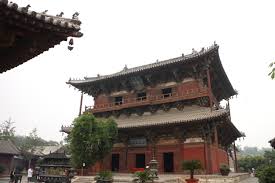| Name ▲▼ | Origin ▲▼ | Description ▲▼ |
|---|---|---|
| Goddess name "Guan Yin/ Guanyin" | Chinese | The goddess of mercy |
The exact date of construction of Dule Temple is unknown, although the celebrated architect Liang Sicheng (1901-1972) dated it back to the early Tang Dynasty at the latest. No Tang relics, however, have been handed down to posterity. The Guanyin Pavil- ion and the main gate were rebuilt in A.D. 984, in the second year of the Tonghe period of the Liao Dynasty, while the monks' quarters and temporary residence for the emperor were constructed in the Ming and Qing dynasties. The last rebuilding of the temple took place in the twenty-sixth year of the Qing Emperor Guangxu's reign (1901), when the emperor and his retinue planned to stop over in the temple en route to the East Imperial Mausoleum at Zunhua County in Hebei Province to pay respects to the royal ancestors. Interesting relics of the temple include the handwriting of the emperor in the Guanyin Pavilion and a horizontal board on the main gate which bears three gilt Chinese characters for Dule Temple, believed to be in the calligraphy of the notorious prime minister Yan Song of the Ming Dynasty ( 1368-1644).
According to Records of Dule Temple, three massa- cres took place in Jixian in the Ming and Qing periods. At each massacre, thousands of Buddhist converts gathered in the temple area to protect the sacred centre of the Jixian people, so that the temple remained intact, although the city was destroyed.
In the Qing period, Dule Temple was out of bounds to the common people and all the ceremon- ies during the annual fair could be held only in front of the temple. In the last years of the Qing Dynasty, a thief made a cozy home of the ceiling of the Guanyin Pavilion for a whole year. He went up and down the pavilion through the pillars on the east side of the building.
In 1928, when a warlord unit was stationed in Dule Temple, the main hall became its barracks. The commander of the unit, Sun Dianying, was also the culprit responsible for robbing the Empress Dowa- ger Ci Xi's tomb in the East Imperial Mausoleum. While the mausoleum had been reduced to a mess, the temple had remained intact because it contained no gold, silver or other treasures.
In the eleventh lunar month of the fourteenth year of the Tianbao period in the Tang Dynasty (A.D. 755), when the An Lushan-Shi Siming Rebel- lion broke out in Yuyang, the rebel chief, An Lu- shah, held an oath-taking rally in Dule Temple. It is said that Dule Temple had previouly been called Avalokitesvara Bodhisattva Temple, before An Lu- shan, obsessed with the desire to become an emper- or and have all the worldly pleasures to himself, renamed it as Dule (meaning solitary happiness) on the eve of his rebellion.

